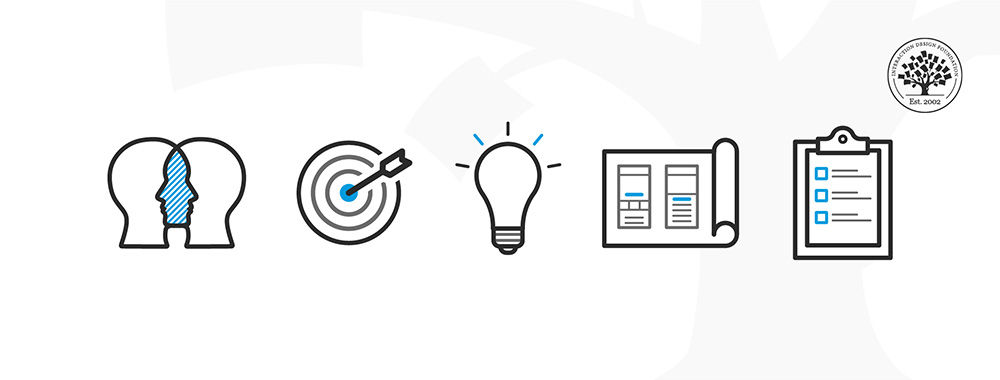What is Design Thinking and Why Is It So Popular?

- 1.6k shares
- 4 mths ago
Outside-the-box thinking is an ideation form where designers freely discard common problem-solving methods to find the true nature of users’ problems, falsify old assumptions and be innovative. Vital to the design thinking process, out-of-the-box thinking means reframing problems with a wider grasp of the design space.
“Thinking outside of the box allows you to get rewards outside of your reach.”
— Matshona Dhliwayo, Philosopher, entrepreneur & author
See where—and what—thinking outside the box can get you:
Traditional approaches to problem-solving can distort design teams’ views of problems. The most innovative solutions—both in product design and service design—usually come from designers who dared to step off the path of linear thinking to ask “Why?”. Design problems are usually complex, with many hard-to-see factors at play between users, the diverse realities they face and solutions they would find most effective, helpful and desirable. To follow a vertical, linear train of thought when addressing these would likely soon cause some big obstacles. With outside-the-box thinking, you can challenge assumptions that would otherwise constrain you, therefore freeing you to sidestep the dangers of meeting a design problem head-on.
Thinking outside the box can save you and your team the headaches of pursuing a perceived problem and ending up developing uninventive, semi-effectual solutions. So, instead of chasing shadows, you can work your way around the boundaries and explore the bigger picture. Moreover, it's a great way to discover other resources that might be available to you, spot market gaps and, indeed, inspire your design team in the ideation stage of any project. That’s why thinking out of the box is synonymous with, and integral to design thinking.
“The box” is the apparent constraints of the design space and our restrictions in perspective from habitually meeting problems as everyday “if x, then do y to get z” tasks. That clinical, critical line of reasoning we’re used to outside the design space will easily impose its limitations in design ideation. You can’t get a holistic view of the problem unless you start to explore horizontally and find its edges. To get outside the box, it’s important to:
Focus on overlooked aspects of a situation/problem.
Challenge assumptions – about any aspect of the problem or users.
Seek alternatives – not just alternative potential solutions, but alternative ways of thinking about problems.
© Yu Siang and Interaction Design Foundation, CC BY-SA 3.0
Lateral thinking and divergent thinking methods can lead to the best results. Early in the ideation stage is the time to get disruptive and reconnect with a similar sense of wonder to how children challenge the norms which adults grow to accept without question. A persistence with “Why?” is the key, as is a judgement-free atmosphere in your ideation session. You want to ask significant questions that may seem outlandish – the idea being to scrutinize the assumptions everyone else would go along with because they’re “the done thing” and see if they’re actually valid.
Essentially, you want to reframe the problem and:
Understand what’s constraining you and why.
Find new strategies to solutions and places/angles to start exploring.
Find the apparent edges of your design space and push beyond them – to reveal the bigger picture.
Of the various methods you can use, a chief one is provocations, where you make deliberately false statements about an aspect of the problem/situation. This could be to question the norms through contradiction, distortion, reversal (i.e., of assumptions), wishful thinking or escapism, for example:

Here, we see some norms of conventional air travel challenged and some unpredictable (and even socially unacceptable) notions to trigger our thinking. Our example showcases this method:
Bad Ideas – You think up as many bad or crazy ideas as possible, but these might have potentially good aspects (e.g., having self-contained compartments with toilets for passengers traveling together). You also establish why bad aspects are bad (e.g., raising prices so exorbitantly would A) foster social exclusion and B) not guarantee safety, anyway).
Design thinking is ideal for outside-the-box thinking, especially since its fluidity as a process lets you iteratively research, ideate, prototype and more as you fine-tune your way to the best solution. Ultimately, you should be able to investigate your problem—including factors affecting it—and harvest insights from its many dimensions by brainstorming or other means. From there, you use convergent thinking to zero in on the best solutions.
© Yu Siang and Interaction Design Foundation, CC BY-SA 3.0
Take our Creativity course, featuring outside-the-box thinking.
Read how one design team leveraged outside-the-box thinking to great effect.
Grammarly’s blog succinctly captures the idea.
This video aptly answers the question of how to think outside the box.
Thinking outside the box means thinking freely and creatively—off the beaten path. It encourages a departure from standard or predictable thinking. It implies adopting unconventional and innovative approaches to problem-solving. Here is what you can do to get started:
Dive into the corners others might miss. Look beyond the obvious and focus on elements often overlooked in a situation.
Question the assumptions entrenched in the problem or regarding the users. Challenge the "given" and ask whether those assumptions are valid.
Don't settle for the expected. Seek not only solutions but also how to frame and approach the problem.
Yes, thinking outside the box is a valuable skill in problem-solving. It goes beyond regular solutions by exploring overlooked aspects, challenging norms, and looking past apparent boundaries. The skill involves questioning the usual ways of doing things and finding innovative solutions. The essence lies in addressing the edges and pushing beyond them to develop a dynamic and creative mindset.
Thinking outside the box involves lateral and divergent thinking methods.
During the ideation stage, be disruptive, persistently ask "Why?" and create a judgment-free atmosphere.
Reframe the problem by understanding constraints, finding new strategies, exploring different angles, and pushing beyond apparent boundaries to reveal the bigger picture.
Use provocations, such as deliberately false statements, to question norms and challenge assumptions.
Here are a few innovative ideas from the home to the workplace:
At Home - Imagine you have a small, unused space under your staircase at home. Comfortable seating, soft lighting, and bookshelves can turn an overlooked area into an inviting space. It demonstrates a creative use of space beyond its "supposed" purpose.
At Work - A common challenge in an eCommerce app is a high rate of product returns. It mainly happens because customers need more certainty about how items will look on them. So, you incorporate augmented reality (AR) for virtual product try-ons to enhance user satisfaction.
Creativity in thinking outside the box means introducing fresh and different ideas and breaking away from the norm. It is like analyzing other paths. The process involves exploring alternative options, questioning the "done thing," and finding clever solutions to problems. This video on Edward de Bono's "thinking hats" framework shows the connection between creative thinking and outside-the-box thinking. The "thinking hats" framework disrupts routine thinking, sparks creativity, and helps find new ideas and answers that change how to tackle challenges.
An open and dynamic perspective provides a continuous flow of imaginative thinking. Creativity and outside-the-box thinking are about going beyond regular thinking to find possibilities. It paves the way for smart solutions and makes problem-solving more interesting.
Thinking outside the box is closely tied to critical thinking. While critical thinking is a part of the process, thinking outside the box goes a step further.
Critical thinking involves analyzing, evaluating, and reasoning through information to make judgments. It encourages exploring alternative perspectives and solutions.
Thinking outside the box focuses more on creative problem-solving and challenging assumptions. It involves questioning assumptions, challenging traditional norms, and reframing problems with a broader understanding.
Thinking outside the box shares similarities with critical thinking but is not synonymous. So, while complementing each other, they represent distinct aspects of cognitive processes.
Thinking outside the box is a positive and valuable approach. It is about looking at things differently, not just sticking to the usual ideas. Such techniques make problem-solving more exciting and compelling.
While the initial introduction of unconventional ideas might seem impractical or risky, the long-term benefits are substantial. This approach has the potential to handle creative blocks, lead to breakthroughs, and overcome limitations imposed by traditional thinking.
You can sign up for our comprehensive course 'Creativity: Methods to Design Better Products and Services, to learn more about outside-the-box thinking. It equips you with skills and step-by-step methods to enhance your ability to generate innovative and valuable solutions. You will gain practical insights and tools to foster creativity in various workflows, programming algorithms, and professional settings.
Learn about hands-on ideation methods.
Explore more about divergent and convergent thinking in this video:
Remember, the more you learn about design, the more you make yourself valuable.
Improve your UX / UI Design skills and grow your career! Join IxDF now!
You earned your gift with a perfect score! Let us send it to you.
We've emailed your gift to name@email.com.
Improve your UX / UI Design skills and grow your career! Join IxDF now!
Here's the entire UX literature on Outside the Box Thinking by the Interaction Design Foundation, collated in one place:
Take a deep dive into Outside the Box Thinking with our course Creativity: Methods to Design Better Products and Services .
Master complex skills effortlessly with proven best practices and toolkits directly from the world's top design experts. Meet your experts for this course:
Alan Dix: Author of the bestselling book “Human-Computer Interaction” and Director of the Computational Foundry at Swansea University.
Don Norman: Father of User Experience (UX) Design, author of the legendary book “The Design of Everyday Things,” and co-founder of the Nielsen Norman Group.

We believe in Open Access and the democratization of knowledge. Unfortunately, world-class educational materials such as this page are normally hidden behind paywalls or in expensive textbooks.
If you want this to change, , link to us, or join us to help us democratize design knowledge!
